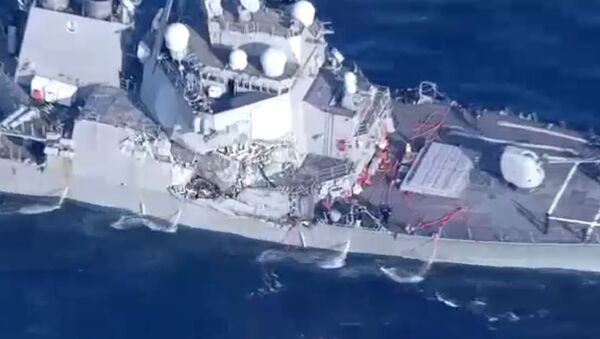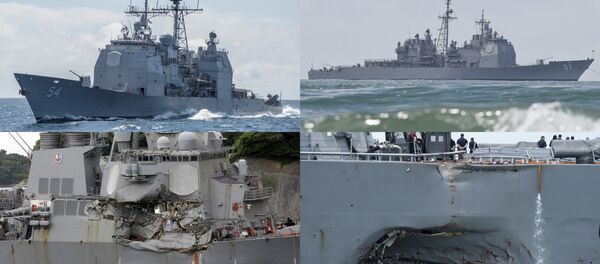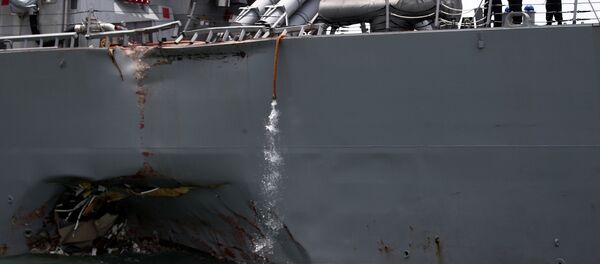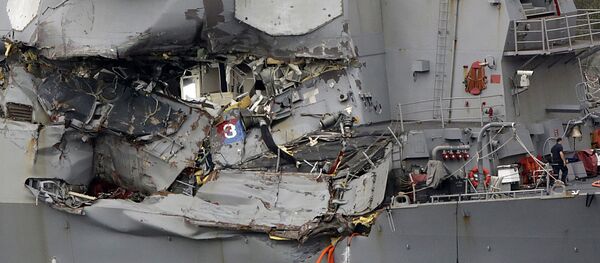In the waters off Yokosuka, Japan, on the night of June 17, 2017, the Arleigh Burke-class destroyer USS Fitzgerald collided with the container vessel ACX Crystal, which flew under a Filipino flag, and seven US sailors died. While public statements by the Navy have subsequently confirmed that the destroyer crew was at fault and that the crew was remarkably unqualified for its tasks, the service's internal probe was all the more scathing, reported the Navy Times, which obtained a copy of the report for a Sunday article.
The report was completed 11 days after the accident and was overseen by Rear Adm. Brian Fort, but was kept secret at the time to protect the service from lawsuits, the publication noted.
Fort's investigation describes a nightmare scenario: unqualified, understaffed crew performing dangerous transits of busy waterways unsupervised, often using defective equipment — and that's when they knew how to use it, which wasn't often the case.
Not only were skippers and executive officers often absent from the bridge during dangerous voyages, the ship lacked a quartermaster chief petty officer, who the Times notes is a "crucial leader who helps safely navigate a warship and train its sailors." Junior officers were found to be in the habit of not reporting or notifying superiors of dangerous instances, such as near-misses with other ships.
What's worse, the Navy knew about all of this.
Fort's report also underscores the failure of the Fitzgerald's crew to learn valuable lessons from both their own near-misses at sea prior to the June 2017 accident as well as other similar incidents elsewhere in the Navy.
Just weeks earlier, the Fitzgerald was involved in an incident near the Japanese city of Sasebo in which a junior officer "became confused by the surface contact picture" of ships near the Fitzgerald, requesting help from the destroyer's then-commanding officer, Cmdr. Robert Shu, who was absent from the bridge at the time, the report notes.
After setting a correct course for the ship to sail behind a vessel in front of the Fitzgerald, Shu then left the bridge, and moments later, a brand new crisis revealed itself: another ship was immediately in front of the destroyer, just on the other side of the first ship!
Fortunately the Fitzgerald avoided that collision, although it took throwing the engines into full reverse and sounding the nautical danger signal — five short blasts on the horn — in order to escape the situation.
"[Fitzgerald's] command leadership was unaware of just how far below standards their command had drifted," Fort's report said. "Had the [commanding officer] and [executive officer] critiqued the near-collision, they may have identified the root causes uncovered by this investigation."
Instead, on the fateful June night five weeks later, the Fitzgerald made no attempt to avoid the collision at all, Sputnik reported. A frightfully similar situation was at hand: a junior officer commanded the ship, her superiors distracted by paperwork and failing to oversee the inept crew's transiting of a very dangerous waterway.
That officer, Lt. junior-grade Sarah Coppock, pleaded guilty to a dereliction of duty charge at court-martial last year. The ship's commanding officer, Cmdr. Bryce Benson, and Lt. Natalie Combs, who ran the combat information center (CIC) on the ship's bridge, are fighting similar charges.
The CIC was a mess, Fort's report notes. He describes kettlebells on the floor and bottles filled with urine, noting some radar controls that didn't work and crew members who didn't know how to use them even if they did.
"Procedural compliance by Bridge watchstanders is not the norm onboard [the Fitzgerald], as evidenced by numerous, almost routine, violations of the [commanding officer's] standing orders," not to mention radio transmissions laced with profanity and "unprofessional humor," Fort's report found.
A test administered to the crew by Fort's team about three weeks after the disaster on "rules of the road" for sailing found an average score of 59 percent among the crew, and only three of the ship's 22 officers scored over 80 percent; seven scored below 50 percent.
Further, Sputnik reported that 15 of the Fitzgerald's 22 certifications had expired by the time of collision, with some of its qualifications not having being renewed for almost a year.





